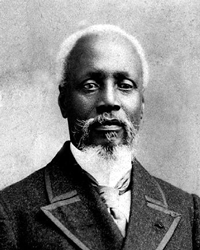Anténor Firmin
| Anténor Firmin | |
|---|---|
 | |
| Minister of Finance, Commerce and Foreign Affairs | |
|
In office December 17, 1896 – July 26, 1897 | |
| President | Tirésias Simon Sam |
| Preceded by |
Callisthènes Fouchard (Finance and Commerce) Pourcely Faine (Foreign Affairs) |
| Succeeded by | Solon Ménos |
|
In office October 29, 1889 – May 3, 1891 | |
| President | Florvil Hyppolite |
| Preceded by |
Saint-Martin Dupuy (Finance and Commerce) Himself (Foreign Affairs) |
| Succeeded by | Hugon Lechaud |
| Minister of Foreign Affairs, Agriculture and Worship | |
|
In office August 22, 1889 – October 29, 1889 | |
| President | Florvil Hyppolite |
| Preceded by |
Saint-Martin Dupuy (Foreign Affairs) Néré Numa (Agriculture) Maximillien Laforest (Worship) |
| Succeeded by |
Himself (Foreign Affairs) Clément Haentjens (Agriculture) Léger Cauvin (Worship) |
| Member of the provisional Government of the Republic of Haiti | |
|
In office August 22, 1889 – October 9, 1889 | |
| Personal details | |
| Born |
Joseph Auguste Anténor Firmin 18 October 1850 Cap-Haïtien, Haiti |
| Died |
19 September 1911 (aged 60) Saint Thomas, DWI |
| Nationality | Haitian |
| Political party | Parti libéral |
| Spouse(s) | Marie Louise Victoria Rosa Salnave |
| Children |
Anne-Marie Firmin Georges Anténor Firmin |
| Profession | Anthropologist, Egyptologist, Politician and Journalist |
Joseph Auguste Anténor Firmin (18 October 1850 – 19 September 1911), better known as simply Anténor Firmin, was a Haitian anthropologist, journalist, and politician. Firmin is best known for his book De l'égalité des races humaines (English: On the Equality of Human Races), which was published as a rebuttal to French writer Count Arthur de Gobineau's work Essai sur l'inégalité des races humaines (English: Essay on the Inequality of Human Races). Gobineau's book asserted the superiority of the Aryan race and the inferiority of blacks and other people of color.
Firmin's work, first published in 1885, argued the opposite, that "all men are endowed with the same qualities and the same faults, without distinction of color or anatomical form. The races are equal" (pp. 450). He was marginalized at the time for his beliefs that all human races were equal.[1]
Firmin pioneered the integration of race and physical anthropology and may be the first black anthropologist. His work was recognized not only in Haiti but also among African scholars as an early work of négritude. He had an impact on Jean Price-Mars, the founder of Haitian ethnology and on American anthropologist Melville Herskovits.[2]
Born in Cap-Haïtien, Firmin worked in teaching, politics, and diplomacy. He founded Le Messager du Nord, a political and literary publication.
Of the Equality of Human Races
In his best known work, De l'égalité des races humaines (aka Of the Equality of Human Races) published in 1885, Firmin tackles two bases of existing theories on black inferiority in an effort to critique Gobineau's De l'Inégalité des Races Humaines (aka Of the Inequality of Human Races). On the one hand Firmin challenges the idea of brain size or cephalic index as a measure of human intelligence and on the other he reasserts the presence of African Blacks in pharaonic Egypt. He then delves into the significance of the Haitian Revolution of 1804 and ensuing achievements of Haitians such as Léon Audain and Isaïe Jeanty in medicine and science and Edmond Paul in the social sciences. (Both Audain and Jeanty had obtained prizes from the Académie de Médecine de Paris.) [3]
Founder of Pan-Africanism
Firmin is one of three Caribbean men who launched the idea of Pan-Africanism at the end of the 19th century to combat colonialism in Africa. As a candidate in Haiti's 1902 presidential elections, he declared that the Haitian state should "serve in the rehabilitation of Africa". Along with Trinidadian lawyer Henry Sylvester Williams and fellow Haitian Bénito Sylvain, he was the organizer of the Panafrican Conference which took place in London in 1900. That conference launched the Panafricanism movement. W.E.B. Dubois attended the conference and was put in charge of drafting the general report. After the conference, 5 panafrican congresses were held in the 20th century which eventually led to the creation of the African Union.[4]
Pan-Caribbeanism
Anténor Firmin devised between 1875 and 1898 a Caribbean Confederation project which envisioned the unification of Cuba, Haiti, the Dominican Republic, Jamaica and Puerto Rico.[4]
Selected works
- De l'égalité des races humaines - published 1885
- Haïti et la France - published 1891
- Une défense - published 1892
- Diplomate et diplomatie - published 1898
- M. Roosevelt, Président des États-Unis et la République d'Haïti - published 1905
- Lettres de Saint-Thomas - published 1910
Notes
- ↑ Firmin, Anténor; Introduction by Carolyn Fluehr-Lobban (2002). "The Equality of the Human Races". University of Illinois Press. Retrieved 24 January 2010.
- ↑ Fluehr-Lobban, Carolyn (2005). "Anténor Firmin and Haiti's contribution to anthropology". Gradhiva - musée du quai Branly (2005 : Haïti et l'anthropologie): 95–108.
- ↑ Péan, Leslie (2012). Comprendre Anténor Firmin. Haiti: Editions de l'Université d'Etat d'Haiti. pp. 71–72. ISBN 978-99935-57-50-0.
- 1 2 Lara, Oruno D. (2007). Tracées d'Historien. L'Harmattan. pp. 117–119. ISBN 978-2-296-04932-1.
References
- Schutt-Ainé, Patricia (1994). Haiti: A Basic Reference Book. Miami, Florida: Librairie Au Service de la Culture. p. 95. ISBN 0-9638599-0-0.
- Joseph, Celucien L. From Toussaint to Price-Mars: Rhetoric, Race, and Religion in Haitian Thought (CreateSpace Independent Publishing Platform, 2013)
External links
- Une Défense in the Digital Library of the Caribbean
- M. Roosevelt, Président des Etats-Unis et la République d'Haïti in the Digital Library of the Caribbean
- Anténor Firmin (French)
|